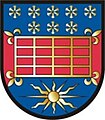Snowflake (heraldry)
Appearance
The snowflake or snow crystal, is a charge in heraldry.
The display in coats of arms is following a strictly stylized form of the natural six pointed crystal form of a snowflake. In older heraldic literature, this charge is not to be seen. In modern heraldry, the snowflake is most used in northern Europe, in arms in Sweden, Norway and Finland, where it alludes to the meteorological features of the lands. Otherwise, it also is a symbol for winter, and together with the sun the changing seasons (e.g. In the arms of Bad Kleinkirchheim, Austria, ), or locally important winter sport (e.g. Saalbach-Hinterglemm, Austria, together with a pair of skis).
The tincture is often argent (silver).
Literature
- Walter Leonhard: Das große Buch der Wappenkunst. Entwicklung, Elemente, Bildmotive, Gestaltung. Lizenzausgabe. Bechtermünz, Augsburg 2001, ISBN 3-8289-0768-7, S. 261.
External links
Wikimedia Commons has media related to Snowflakes in heraldry.









